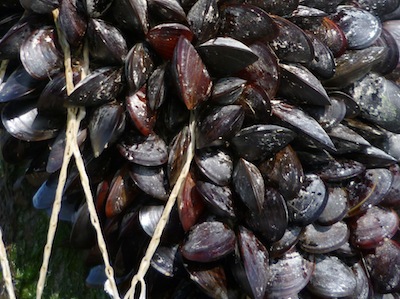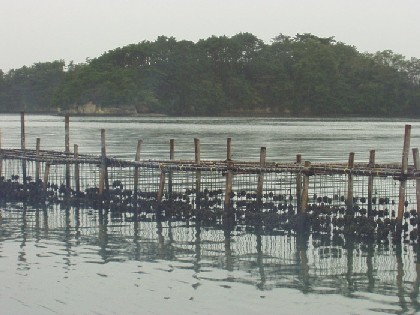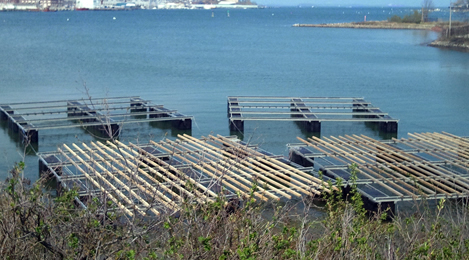
|
||||||||||||
| Fisheries :: Marine Cage | ||||||||||||
|
Mussel Farming
Spawning is initiated by either sex of the green mussel with each releasing two streams of gametes into the water. Spawning has also been induced by the presence of other spawning individuals in the area and a drop in salinity. Females release about 5 lakh eggs. Seven to eight hours after fertilization, the zygote is completely transformed into mobile, trochophore larvae. After 16 to 19 hours the veliger larval stage is reached with the larval shell covering the internal body parts and developing a strong ciliated velum. The straight hinge D shaped larvae metamorphoses to pediveliger with a pedal organ, the functional foot and descends to the bottom. The larvae completely metamorphosize in eight to twelve days. In 10-12 days the larva secretes the initial byssal threads and attaches itself. Changes in organ system takes place and the post larvae with characteristics of adult mussel called spat are formed. Perna viridis has the greatest growth rate of the mussels studied to date. Maximum growth of the green mussel occurs 2m below the surface because of the increased productivity of the water at that depth and a narrow area of temperature and salinity fluctuation. P. viridis is a suspension feeder. This species is an efficient filter feeder, feeding on small zooplankton, phytoplankton and other suspended fine organic material. The high growth rate of the green mussel is related to high salinity and an abundance of phytoplankton. The green mussel has a high tolerance for reduced salinities, increased survival during atmospheric exposure, and high survival rates in turbid water. Mussel culture Techniques The world mussel production (FAO data) during 2006 was 1.89 million tons valued at 1.2 billion US dollars. The world production of Perna viridis during 2006 was 305,321 tons valued at 2.74 million US dollars. The total production of green mussels in India (2008) is about 15,000 tons. Many culture techniques are used for growing mussels worldwide. Some of these are described below
Fixed suspended culture This is the simplest of the rope method used for green mussel cultivation in India and Philippines. The main purpose of the pole is to support the structure. In between these poles, ropes are suspended either vertically or kept horizontally where the depth is a limitation. Availability of seed The seeds required for culture is presently collected from traditional fishing areas and these are often causing conflicts between farmers and mussel fishermen. This year has seen more conflicts than previous years. Hence it is essential that additional spat collectors have to be established along the coast to ensure supply of seeds to the farmers. Marketing The harvesting seasons of cultured mussels is mostly during April – May months and farmers are forced to sell their crop before the onset of monsoon to avoid mass mortality of mussels due to freshwater influx into the backwater system. At present only a few processing plants purchases cultured mussels from the farmers and as a result the local market are flooded with cultured mussels during these months resulting in fall in the prices and thereby affecting the profitability of the operation. Depuration system The main constraint in the export of cultured mussels is the lack of proper depuration techniques. Depuration plants are needed at regular intervals along the coast so as to depurate the cultured mussels for export processing. Storage facility If sufficient cold storage facility is provided, cultured mussels can be depurated, shucked and stored not only for export market but also for local market throughout the year. This will increase the profitability of the culture operation. Post harvest technology: Value added products of longer shelf life need to be developed from mussel meat to increase the revenue realization from cultured mussels. Mussel fry, mussel pickle etc. are some of the best examples for value added products. More studies are needed to develop ethnic cuisines with longer shelf life. Siltation of backwaters Some areas in the backwater system have very high siltation levels especially during rainy season. This often results in mortality of mussels in the farms. Hence scientific feasibility studies are required to demarcate potential culture sites. Silting of the bottoms where culture is done may induce a problem for the benthic communities located underneath. This should be solved by strong policies directed towards correct management of the fouling and silt accumulated by the hanging ropes. Source : Course Manual :
Winter School on
Recent Advances in Breeding and Larviculture
of Marine Finfish and Shellfish - Present Status of Mussel Farming Updated on Feb 2015 |
||||||||||||
© All Rights Reserved. TNAU 2009-15. |
||||||||||||


